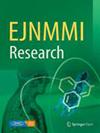全身 PET/CT 扫描仪的性能和应用:文献综述
IF 3.1
3区 医学
Q1 RADIOLOGY, NUCLEAR MEDICINE & MEDICAL IMAGING
引用次数: 0
摘要
全身正电子发射断层扫描/计算机断层扫描(PET/CT)系统具有较长的轴向视野,是最先进的 PET 成像技术。最近,全身正电子发射计算机断层扫描(PET/CT)系统已投入商业使用。全身 PET/CT 系统即使在极端条件下也能进行高分辨率全身成像,如超低剂量、极快的成像速度、示踪剂注射后 10 小时以上的延迟成像和全身动态扫描。全身 PET/CT 系统可提供全身各器官示踪剂的实时图像,不仅有助于解释人体正常生理过程,还便于对全身性疾病进行全面评估。此外,全身 PET/CT 系统还可在癌症成像、药物开发和免疫学等其他医学领域发挥关键作用。因此,总结现有的全身 PET/CT 系统研究并指出其未来发展方向具有重要意义。本综述从 PubMed 数据库中收集了自商用全身 PET/CT 系统出现至今的研究文献,分为以下几个部分:首先,简要介绍了全身 PET/CT 系统,然后总结了有关全身 PET/CT 性能评估的文献。然后,讨论了全身 PET/CT 的研究和临床应用。第四,回顾了基于全身 PET 成像的深度学习研究。最后,讨论了全身 PET/CT 现有研究的不足和未来发展方向。由于其技术优势,全身 PET/CT 系统必将在未来的临床实践中发挥更大的作用。本文章由计算机程序翻译,如有差异,请以英文原文为准。
Performance and application of the total-body PET/CT scanner: a literature review
The total-body positron emission tomography/computed tomography (PET/CT) system, with a long axial field of view, represents the state-of-the-art PET imaging technique. Recently, the total-body PET/CT system has been commercially available. The total-body PET/CT system enables high-resolution whole-body imaging, even under extreme conditions such as ultra-low dose, extremely fast imaging speed, delayed imaging more than 10 h after tracer injection, and total-body dynamic scan. The total-body PET/CT system provides a real-time picture of the tracers of all organs across the body, which not only helps to explain normal human physiological process, but also facilitates the comprehensive assessment of systemic diseases. In addition, the total-body PET/CT system may play critical roles in other medical fields, including cancer imaging, drug development and immunology. Therefore, it is of significance to summarize the existing studies of the total-body PET/CT systems and point out its future direction. This review collected research literatures from the PubMed database since the advent of commercially available total-body PET/CT systems to the present, and was divided into the following sections: Firstly, a brief introduction to the total-body PET/CT system was presented, followed by a summary of the literature on the performance evaluation of the total-body PET/CT. Then, the research and clinical applications of the total-body PET/CT were discussed. Fourthly, deep learning studies based on total-body PET imaging was reviewed. At last, the shortcomings of existing research and future directions for the total-body PET/CT were discussed. Due to its technical advantages, the total-body PET/CT system is bound to play a greater role in clinical practice in the future.
求助全文
通过发布文献求助,成功后即可免费获取论文全文。
去求助
来源期刊

EJNMMI Research
RADIOLOGY, NUCLEAR MEDICINE & MEDICAL IMAGING&nb-
CiteScore
5.90
自引率
3.10%
发文量
72
审稿时长
13 weeks
期刊介绍:
EJNMMI Research publishes new basic, translational and clinical research in the field of nuclear medicine and molecular imaging. Regular features include original research articles, rapid communication of preliminary data on innovative research, interesting case reports, editorials, and letters to the editor. Educational articles on basic sciences, fundamental aspects and controversy related to pre-clinical and clinical research or ethical aspects of research are also welcome. Timely reviews provide updates on current applications, issues in imaging research and translational aspects of nuclear medicine and molecular imaging technologies.
The main emphasis is placed on the development of targeted imaging with radiopharmaceuticals within the broader context of molecular probes to enhance understanding and characterisation of the complex biological processes underlying disease and to develop, test and guide new treatment modalities, including radionuclide therapy.
 求助内容:
求助内容: 应助结果提醒方式:
应助结果提醒方式:


